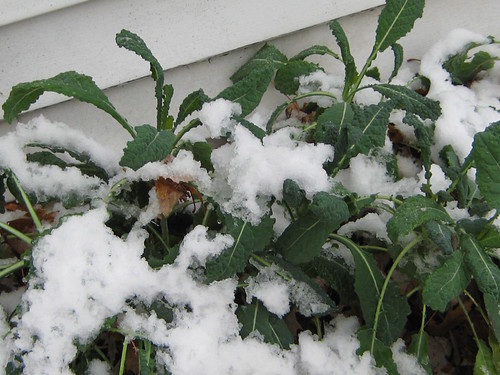think of kale, especially when it's -5 outside
I think about kale a lot, perhaps too much. It's an underrated vegetable for sure, and its resilience to cold and frost deserves some serious respect. I took this picture about six weeks ago in mid-November. By that time, St. Paul, MN experienced two frosts and one snow storm (when I took this picture). I harvested it the same day, to make sure we did not push our luck. If you live in Minnesota, you know that gardens typically do not support life into November, with the exception of a few lucky pumpkins or squash. I planted this purple lacinato kale, an Italian heirloom variety, in late summer in preparation for a fall harvest, since it's always exciting to have a few things to eat after the August/September vegetable rampage. The other day it was -5 at 12:00 pm. It's amazing to think that only one month and a half has passed since eating the last gift from the garden. These thoughts keep me warm during the arctic months.
If you live in Minnesota, you know that gardens typically do not support life into November, with the exception of a few lucky pumpkins or squash. I planted this purple lacinato kale, an Italian heirloom variety, in late summer in preparation for a fall harvest, since it's always exciting to have a few things to eat after the August/September vegetable rampage. The other day it was -5 at 12:00 pm. It's amazing to think that only one month and a half has passed since eating the last gift from the garden. These thoughts keep me warm during the arctic months.
I've posted my favorite kale recipe below. Tuck it away for next season. Now, if you live in the Upper Midwest and you want to cheat, you could buy some California kale, which is in season right now, but it certainly won't be the same as brushing the snow off your own crop.
This recipe serves 4 as a side dish.
ingredients
- 2 large bunches of kale, trimmed of tough stems
- 1 head of garlic
- 1 teaspoon hot red pepper flakes
- ground black pepper
- sea salt
- olive oil
- balsamic vinegar
- heat the oven to 375 degrees
- wrap the garlic in foil and roast for 45 min to 1 hour - garlic should be soft and golden brown. set on the counter to cool.
- while garlic is roasting, bring a large pot of water to boil and add a big pinch of sea salt.
- put the kale in the pot and blanch for 3-4 minutes, until thickest part of leaves is tender (but not mushy!).
- remove kale from pot, put it in a colander, and run cold water over it until it's very cool to the touch.
- using a clean dish towel, squeeze all of the water out of the kale, then pull the individual leaves apart.
- when garlic has cooled, slice the top of the head using a sharp serrated knife and squeeze garlic into a small bowl (it should be nice and pasty at this point). add a pinch of salt and black pepper.
- heat two tablespoons of oil in a small skillet. when the oil is hot, add the red pepper flakes and garlic, stirring constantly for 1 minute to keep them from burning.
- add the kale and saute for 3-4 minutes until hot. remove from heat and stir in a splash of vinegar and another pinch of sea salt. Serve hot or luke warm.



